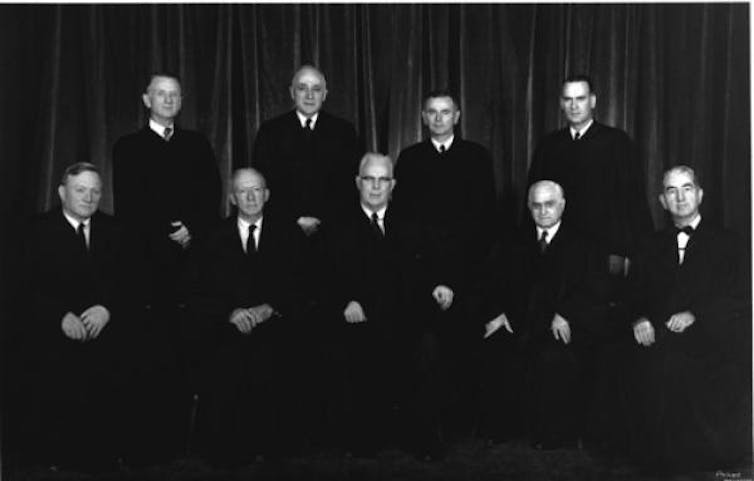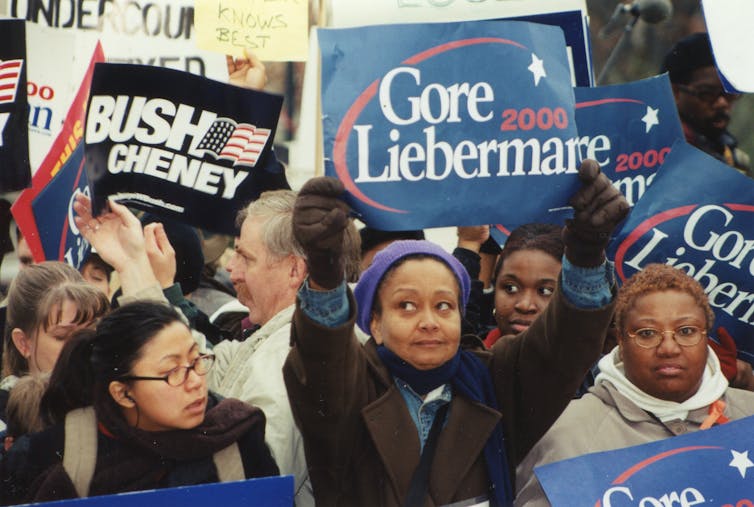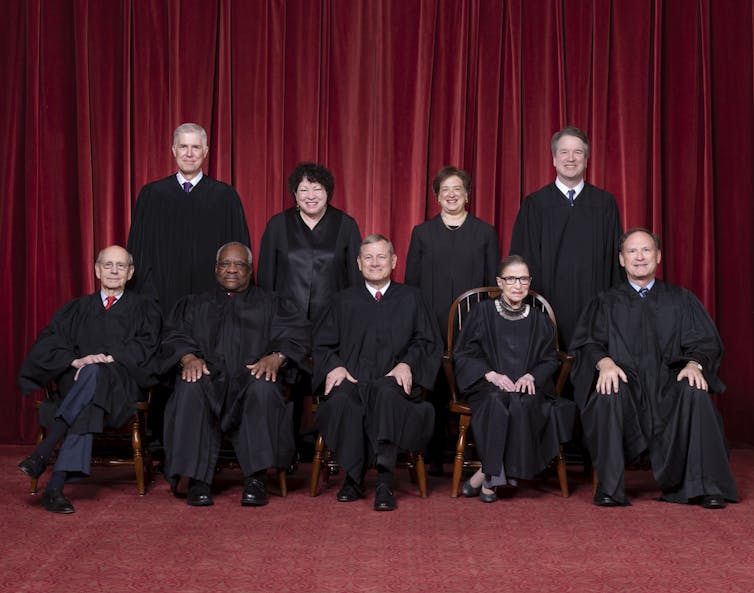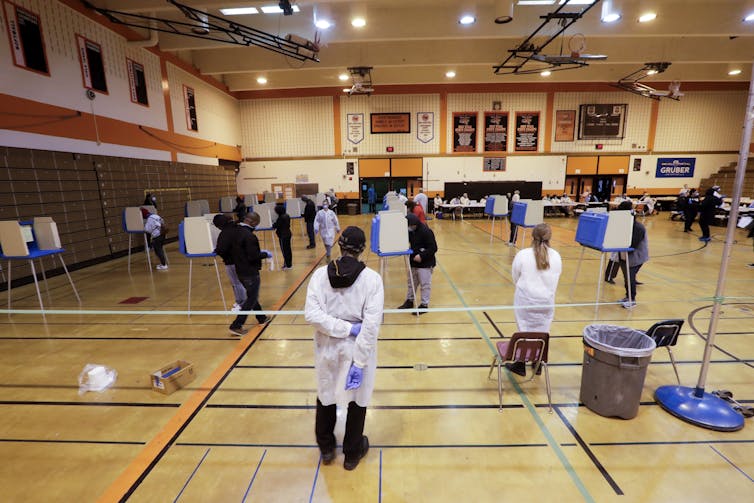Why the Supreme Court made Wisconsin vote during the coronavirus crisis
- Written by Austin Sarat, Professor of Jurisprudence and Political Science, Amherst College
When Wisconsin voters had to brave the coronavirus pandemic to vote in their state’s April 7 election[1], it was the latest phase of a nearly 60-year legal and political fight over who can vote in the U.S.
Wearing masks and gloves[2], Wisconsin residents who voted in person[3] were met by election officials in similar attire. That was new.
But it wasn’t new that voters found hundreds of polling places closed and therefore had to wait in line for hours.
A U.S. Supreme Court decision just the day before had ordered Wisconsin to hold its in-person election without delay[4], not allowing extra time for voters to cast their ballots by mail. Critics called the decision one of “raw partisanship[5],” “an ominous harbinger[6] for what the Court might allow in November in the general election” – and even a “death threat[7]” aimed at voters.
As someone who has long studied[8] the complex intersections of law and politics, I saw the ruling as the latest episode in the fight over the franchise and one of a series of decisions under Chief Justice John Roberts that have rejected efforts[9] to protect or extend voting rights.
 The Warren court from 1958 to 1962. Standing, from left: Justices Charles E. Whittaker, John M. Harlan, William J. Brennan, Jr., Potter Stewart. Seated, from left, Justices William O. Douglas and Hugo L. Black, Chief Justice Earl Warren, and Justices Felix Frankfurter and Tom C. Clark.
Supreme Court of the United States/Wikimedia Commons[10]
The Warren court from 1958 to 1962. Standing, from left: Justices Charles E. Whittaker, John M. Harlan, William J. Brennan, Jr., Potter Stewart. Seated, from left, Justices William O. Douglas and Hugo L. Black, Chief Justice Earl Warren, and Justices Felix Frankfurter and Tom C. Clark.
Supreme Court of the United States/Wikimedia Commons[10]
The Warren court and the vote
In 1886, the Supreme Court recognized[11] that voting is “a fundamental political right, because [it is] preservative of all rights.” So long as people can vote, the justices reasoned, they could fix any problems democracy might encounter.
Starting in 1962, the court, under Chief Justice Earl Warren, responded to suits brought by civil rights groups by issuing a series of rulings[12] based on that 1886 principle. The decisions effectively declared that federal courts would ensure that everyone’s vote counted equally[13] and that barriers to voting would be removed wherever possible.
In Baker v. Carr[14], decided in 1962, the Supreme Court held that judges could review the process of drawing boundaries for legislative districts, and that the 14th Amendment’s guarantee of equal protection of the law required those districts to be roughly equal in population.
Two years later, the Warren court extended this understanding[15] of the 14th Amendment and decided that state legislative districts must guarantee “one person, one vote.” For an 8-1 majority, Chief Justice Warren wrote that because the right to vote was the “bedrock of our political system … any alleged infringement of [it] … must be carefully and meticulously scrutinized.”
In 1966, the court held 6-3 that states could not require voters in state elections to pay a tax[16] before voting. That ruling solidified the court’s role in protecting voters’ free access to cast their ballots. Justice William Douglas wrote for the majority that the right to vote was “too precious, too fundamental to be so burdened or conditioned.”
While the Burger[17] and Rehnquist[18] courts pulled back in some areas of voting rights and were less aggressive in other voting rights cases than the Warren court, they did not aggressively dismantle its legacy – that is, until Bush v. Gore[19].
 Supporters of George W. Bush and Al Gore protest outside the Supreme Court building in December 2000.
Elvert Barnes, CC BY-SA[20][21]
Supporters of George W. Bush and Al Gore protest outside the Supreme Court building in December 2000.
Elvert Barnes, CC BY-SA[20][21]
Bush v. Gore and voting rights
The Supreme Court’s commitment to policing the electoral process in the name of equality and inclusion was shattered when, on Dec. 12, 2000, it stopped a recount[22] in Florida’s closely contested presidential election, ensuring that George W. Bush would become president of the United States.
That 5-4 decision, nearly five years before Bush appointed Roberts to the court, launched an era of bitter partisan division[23] in voting-rights cases that the conservative-majority Roberts court has continued.
In 2008, for instance, the court, dividing 6-3, upheld an Indiana law requiring people to present government-issued identification[24] before being allowed to vote. Despite the disproportionate burden[25] that law placed on minorities and the poor, who are least likely to have such identification, the justices found it to be a legitimate way for the state to prevent voter fraud.
Five years later, by a 5-4 vote[26], the Roberts court ended the 1965 Voting Rights Act’s requirement that states with a history of discrimination against minority groups must get federal approval[27] before changing any voting laws. Roberts himself wrote the majority ruling that the requirement was no longer necessary and it represented an “unconstitutional violation of the power of states to regulate elections.”
 The Roberts court, from 2018. Seated, from left: Justices Stephen G. Breyer and Clarence Thomas, Chief Justice John G. Roberts Jr., and Justices Ruth Bader Ginsburg and Samuel A. Alito. Standing, from left: Justices Neil M. Gorsuch, Sonia Sotomayor, Elena Kagan and Brett M. Kavanaugh.
Fred Schilling, Supreme Court of the United States/Wikimedia Commons[28]
The Roberts court, from 2018. Seated, from left: Justices Stephen G. Breyer and Clarence Thomas, Chief Justice John G. Roberts Jr., and Justices Ruth Bader Ginsburg and Samuel A. Alito. Standing, from left: Justices Neil M. Gorsuch, Sonia Sotomayor, Elena Kagan and Brett M. Kavanaugh.
Fred Schilling, Supreme Court of the United States/Wikimedia Commons[28]
The Roberts court’s assault continues
In 2017, there was a brief break in the Roberts court’s predictable ideological rulings in voting rights and election cases. In an unusual alignment, Justice Thomas joined the four liberal justices to strike down a North Carolina law that allowed racist gerrymandering[29].
But a year later, in yet another 5-4 ruling, the court allowed states to purge residents[30] from the voting rolls for, among other things, failing to vote for two years. Ohio claimed it used that failure as a rough way of identifying voters who may have moved and tried to get them to verify their residence by mailing them a postcard. Yet the effect of the law[31] was that many people who showed up to vote for a subsequent election would be prevented from actually voting.
And in 2019, the court again split 5-4, holding that courts should stay out of cases[32] alleging that redistricting maps were drawn to favor one political party at another’s expense. The court concluded that while the practice of partisan gerrymandering may be distasteful, it is a political problem, not a legal one.
 A Milwaukee high school gym was converted into a polling place on April 7, with voting booths set apart from each other and election workers wearing masks and gloves.
AP Photo/Morry Gash[33]
A Milwaukee high school gym was converted into a polling place on April 7, with voting booths set apart from each other and election workers wearing masks and gloves.
AP Photo/Morry Gash[33]
The future of voting rights
That set the stage for the Wisconsin situation, in which the Democratic governor, the Republican-dominated state legislature, the state Supreme Court and a federal district court issued a series of contradictory decisions and rulings[34] about whether the election could take place and voters could have extra time to submit absentee ballots.
The five U.S. Supreme Court justices appointed by Republican presidents[35] said the case only raised “a narrow, technical question about the absentee ballot process.” They invoked a view articulated by the Roberts court in 2006 that “lower federal courts should ordinarily not alter the election rules[36] on the eve of an election,” even as the nation’s highest court did exactly that.
The court’s liberal justices objected. Led by Justice Ruth Bader Ginsburg, they wrote that they viewed the case as about much more than a small technicality[37], but rather “a matter of utmost importance – to the constitutional rights of Wisconsin’s citizens, the integrity of the State’s election process, and in this most extraordinary time, the health of the Nation.” Ginsburg’s dissent warned that “the court’s decision risks that tens of thousands of voters will be disenfranchised.”
That decision sent what I believe to be a clear message to Americans: Don’t turn to the Supreme Court to protect your right to vote, even in the case of a genuine emergency. If the coronavirus crisis was not enough to overcome partisan divisions among the justices about something as fundamental as voting, it is hard to imagine what will.
Americans wanting to protect voting rights face a dilemma. With a federal judiciary no longer willing to protect Americans’ right to vote, it is left to the people themselves to do so by voting for candidates who pledge to protect the franchise. But they may have a hard time accomplishing this when elections[38] are made less equal and less inclusive by the Roberts court’s decisions.
[Get facts about coronavirus and the latest research. Sign up for The Conversation’s newsletter.[39]]
References
- ^ to vote in their state’s April 7 election (www.washingtonpost.com)
- ^ Wearing masks and gloves (nymag.com)
- ^ voted in person (www.politico.com)
- ^ hold its in-person election without delay (www.supremecourt.gov)
- ^ raw partisanship (www.nytimes.com)
- ^ an ominous harbinger (www.theatlantic.com)
- ^ death threat (www.nytimes.com)
- ^ has long studied (openscholarship.wustl.edu)
- ^ rejected efforts (papers.ssrn.com)
- ^ Supreme Court of the United States/Wikimedia Commons (commons.wikimedia.org)
- ^ recognized (supreme.justia.com)
- ^ series of rulings (www.jstor.org)
- ^ federal courts would ensure that everyone’s vote counted equally (scholarship.law.unc.edu)
- ^ Baker v. Carr (supreme.justia.com)
- ^ extended this understanding (www.oyez.org)
- ^ could not require voters in state elections to pay a tax (supreme.justia.com)
- ^ Burger (www.press.umich.edu)
- ^ Rehnquist (ir.lawnet.fordham.edu)
- ^ Bush v. Gore (supreme.justia.com)
- ^ Elvert Barnes (commons.wikimedia.org)
- ^ CC BY-SA (creativecommons.org)
- ^ stopped a recount (supreme.justia.com)
- ^ bitter partisan division (ssrn.com)
- ^ people to present government-issued identification (supreme.justia.com)
- ^ disproportionate burden (www.wired.com)
- ^ by a 5-4 vote (supreme.justia.com)
- ^ must get federal approval (www.justice.gov)
- ^ Fred Schilling, Supreme Court of the United States/Wikimedia Commons (commons.wikimedia.org)
- ^ a North Carolina law that allowed racist gerrymandering (supreme.justia.com)
- ^ allowed states to purge residents (supreme.justia.com)
- ^ the effect of the law (www.nytimes.com)
- ^ courts should stay out of cases (supreme.justia.com)
- ^ AP Photo/Morry Gash (www.apimages.com)
- ^ series of contradictory decisions and rulings (www.nytimes.com)
- ^ appointed by Republican presidents (newrepublic.com)
- ^ not alter the election rules (supreme.justia.com)
- ^ much more than a small technicality (qz.com)
- ^ have a hard time accomplishing this when elections (www.yalelawjournal.org)
- ^ Sign up for The Conversation’s newsletter. (theconversation.com)
Authors: Austin Sarat, Professor of Jurisprudence and Political Science, Amherst College

